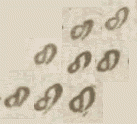Roman numerals
In most Scottish documents of the period 1500-1750, Roman numerals or words are used for numbers. It is only later in the period that Arabic numerals are found more regularly. An i for 1 on its own or at the end of a number will be rendered as j. x is 10, L is 50 and C is 100.
|
|
|
Numbers as words
Below is a sample list of Scots words used in dates and numbers. As with all words, it was mostly down to the individual clerk how he spelt a word. It is not unusual to find clerks spelling the same word differently within the same document. The list below is a sample and should not be taken as a definitive list.
|
|
|
Arabic numerals
Arabic numerals written in Scottish documents in the period 1500-1800 are fairly recognisable (i.e. the way of writing them has not changed significantly between the sixteenth century and today), with the exception of two numerals: the six and the eight.
As you can see from the image below, some writers had a tendency to exaggerate the upper stroke of the 6 by elongating it and making it slope diagonally upwards.
Note how this compares to an early-modern form of the numeral eight (the image below shows the 8 and the 6)
In a series of numerals, it might be difficult to tell it apart from the numeral 5. In the example of the date 1665 below, the writer has made the numeral 5 quite elaborate to distinguish it from the 6s preceding it.

The exaggerated, sloping 6 might be confused with the letters b, v and o. To help you memorise this form of the early-modern 6, the image below shows six sloping sixes.

In seventeenth and eighteenth century documents the number 8 is often written in a form where the top loop is slightly to the right of the lower loop, as you can see in the example below.
In most written text this is not a great problem, but in a string of numerals you can see how this might be confused with a 6. Where the numeral appears beside letters, it can be more of a problem. At first sight the example below might easily be confused with hieroglyphics, but represents a sum of money: six shillings and eight pence - the numeral 6 followed by the scharfes s (representing the Latin word solidi, meaning shillings), then the numeral 8, then the letter d (representing the Latin word denarii, meaning pennies).

This form of the numeral 8 looks somewhat like a pelican - the top loop looks like a beak and the bottom loop like the pelican's body. So, to help you remember that a digit which looks like a pelican is an 8, here is a flock of 8 little pelicans.
